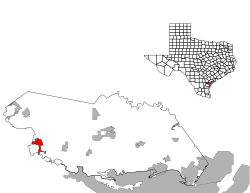San Patricio, Texas | |
|---|---|
 Location of San Patricio, Texas | |
 | |
| Coordinates: 27°57′33″N97°46′23″W / 27.95917°N 97.77306°W | |
| Country | United States |
| State | Texas |
| County | San Patricio |
| Area | |
• Total | 3.89 sq mi (10.07 km2) |
| • Land | 3.85 sq mi (9.97 km2) |
| • Water | 0.039 sq mi (0.10 km2) |
| Elevation | 43 ft (13 m) |
| Population (2020) | |
• Total | 384 |
| • Density | 97.5/sq mi (37.63/km2) |
| Time zone | UTC-6 (Central (CST)) |
| • Summer (DST) | UTC-5 (CDT) |
| ZIP code | 78368 |
| Area code | 361 |
| FIPS code | 48-65612 [2] |
| GNIS feature ID | 1346436 [3] |
San Patricio is a city in San Patricio County in the U.S. state of Texas. The population was 384 at the 2020 census.
Contents
In the 2000 U.S. census, a portion of San Patricio was indicated as being in Nueces County. [4] As of the 1990 U.S. census, the 2010 U.S. census, and the 2020 U.S. census, that particular area is indicated as being in San Patricio County. [5] [6] [7]
